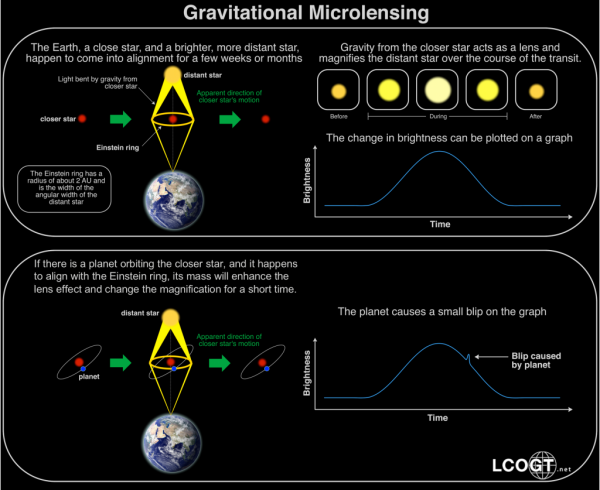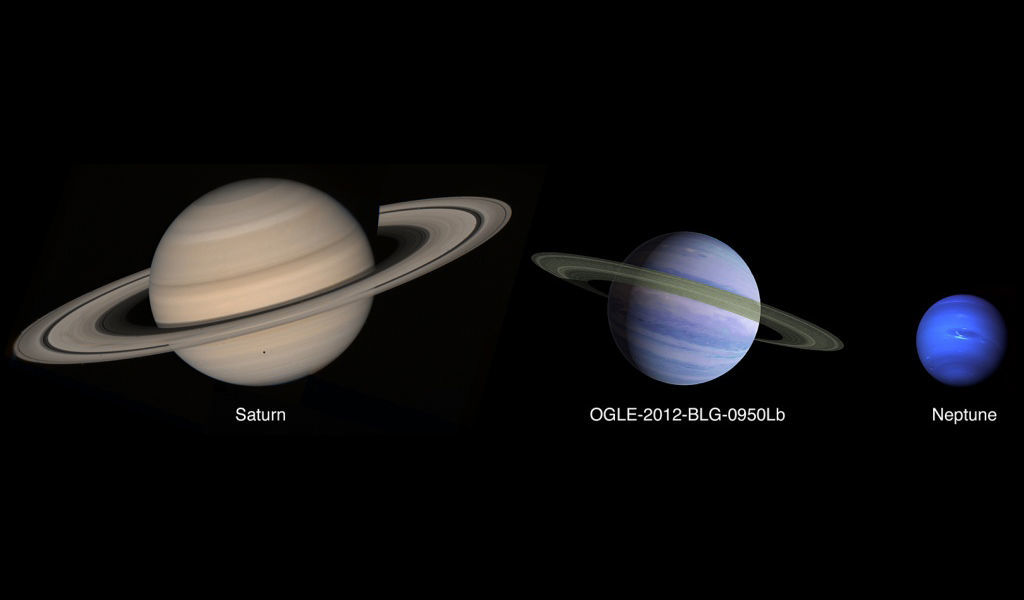Astronomers find a rare ‘super-Neptune’ thanks to Einstein – SYFY WIRE
The scientific field of exoplanets — planets orbiting other stars — is booming. We’re within grasp of detecting the 4,000th confirmed alien world, which to me is a staggering number. I remember when the first one was found! It wasn’t that long ago, just in 1992.
With so many exoplanets catalogued, it’s possible to mine this data to look for trends. Do certain kinds of stars make planets better than others? Are planets more common orbiting very close to their stars, or farther out like in our solar system? And so on.
Even very simple questions can yield profound answers. For example, what’s the size distribution of planets? In our solar system we have four small ones, two that are bigger, and two that are really big. It’s a big jump from Earth to Neptune (which has about 17 times Earth’s mass) and then again from Neptune to Saturn (which has 95 times Earth’s mass). Are there planets orbiting other stars with masses in these gaps?
Yes! Well, kinda. We see lots of planets in the Earth-Neptune gap (called super-Earths or mini-Neptunes, depending on which side of the gap they’re closer to). But we don’t see many super-Neptunes. That’s interesting! There’s a hypothesis that we shouldn’t see many planets from 20–80 times the mass of Earth — once a forming planet gets more massive than Neptune, its gravity grows so quickly that it starts to accumulate a lot more mass, becoming more like Saturn or Jupiter.
But is that actually the case? It turns out it’s hard to know, because this hypothesis works best for planets that are pretty far out from their host star — out past what’s called the snow line, where water forms ice in space — and most of our methods of finding planets aren’t sensitive to ones that far out.
… except one. And this method is starting to find these weird super-Neptunes. .
OK, I’ll get to that alphanumeric soup of a planet in a sec. Let me first briefly describe how it was found. The method is called gravitational lensing, and I’ve written about it before. Basically, if a star or planet gets directly between us and an even more distant star, the light from that background star gets distorted due to the gravity of the intervening object. If the intervening object (called the lens, since it’s bending the light from the more distant star) is moving across our line of sight, the light we see from the background star can grow brighter or dimmer over time.
The details can be pretty complicated, but it’s a pretty reliable way of detecting lensing objects that are otherwise too faint or too distant to see otherwise. It was predicted using Einstein’s equations of relativity about how mass bends space, and is yet another wonderfully useful tool that’s come from that.
This method works really well; have been found this way. There’s even a survey of the sky that looks for just such lensing events, called OGLE — the Optical Gravitational Lensing Experiment. In 2012, for example, it found a planet orbiting a star as they both lensed light from an even more distant star. The star found is called OGLE-2012-BLG-0950L, and the planet the same with a lower-case “b” after it. I’ll call them BLG-0950L and BLG-0950Lb for short.

If a star passes between Earth and a more distant star (top), its gravity can bend the light from that star, making it appear brighter. If a planet orbits that closer star (bottom), that can be detected as well. Credit:
The event happened because as it orbits the center of our galaxy, the star BLG-0950L happened to pass nearly directly between us and a background star. As it passed, astronomers saw the light from the background brighten and dim over the course of several weeks. There were actually two such variations; a big one due to the star and a smaller one due to the planet.
There’s a lot of info you can get from this event, but unfortunately the mass of the star and the planet are not measurable independently. You only get their ratio, and in this case they found the planet had about 0.01% the mass of the star. But what’s the mass of the star?
. During the lensing event, the background and lensing stars were so close together in the sky they couldn’t be separated. So the astronomers waited 6 years, then looked at the star again using both Hubble in orbit and the massive Keck 10-meter infrared telescope in Hawaii. Enough time had passed that BLG-0950L and its planet had moved well past the background star as seen from Earth, far enough that they were distinguishable! The separation was still mighty small, but using clever techniques the astronomers were able to distinguish them.
That allowed them to analyze what kind of star BLG-0950L is, and they found it to be an orange K-type dwarf with about 0.6 times the mass of the Sun, and lying about 7,000 light years away. The planet therefore has a mass of about 40 times the Earth, and orbits the star about 380 million kilometers out. That’s farther out than the star’s snow line…
… right in the middle of that hypothesized mass desert between Neptune and Saturn.
So that’s interesting. The hypothesis says there shouldn’t be planets there, yet BLG-0950Lb is. Does this prove the hypothesis wrong?

Artist’s depiction of the planet OGLE-2012-BLG-0950Lb, which is intermediate in mass between Neptune and Saturn. The rings are just an artistic flourish; we don’t know if the planet has rings or not. Credit:
Maybe. Maybe not. Maybe the mass measurement isn’t correct (though it looks pretty good to me). Maybe there are exceptions, which is always something to keep in mind. It’s possible there are very few such planets, and not none.
Tantalizingly, and also didn’t see any gap between Neptune and Saturn, but they didn’t see enough planets to be really sure; we need to have a lot more gravitational lensing events to get a good statistical grip on this.
In fact both that paper and the one here both use a technique that was developed for use with WFIRST, the Wide-field Infrared Survey Telescope, a future NASA mission that will survey the sky and find loads of exoplanetary lenses. Right now, though, the future of that mission is in doubt due to Trump’s 2020 NASA budget canceling it. The White House did this in the 2019 budget as well, but Congress restored the funding to develop WFIRST. Let’s hope they do it again this year.
So the bottom line is that theory predicts one thing, but observations are starting to show cracks in it. We don’t have enough observations yet to be sure, but those will come in time. The question is whether we still have to stumble on them looking in small parts of the sky, or if we’ll have a treasure trove of them from WFIRST to sift through. If the latter, then “treasure” is what it will be; we’ll find enough to start looking for even more interesting and more detailed trends, and learn huge amounts about how planets form and evolve over time.
That, to me, is amazing. We have a chance to investigate a component of the Universe that, until 1992, we only suspected existed, and now we know of thousands. Eventually we’ll know of millions. Billions.
We just have to choose to find them. What hypotheses will we have to dump into the trash bin then, and what new ones will we dream up?






